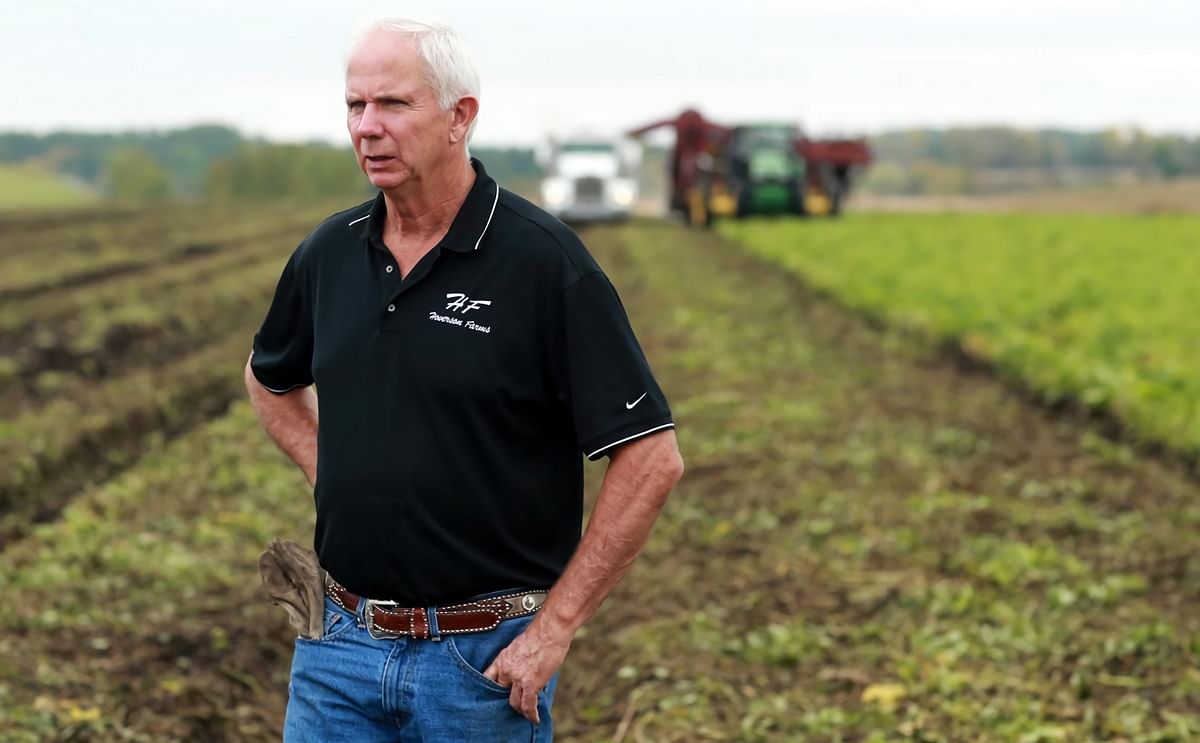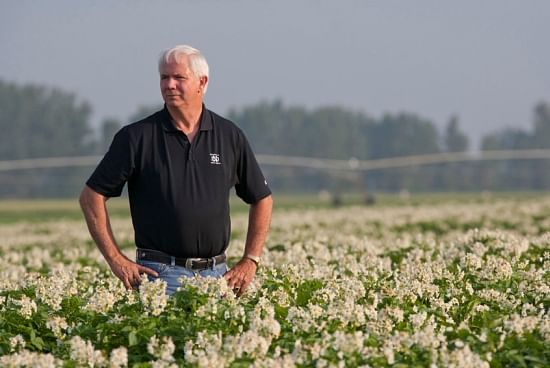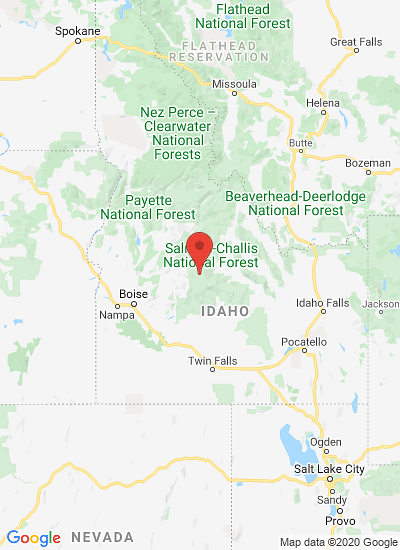Carl Hoverson elected Chairman of the United States Potato Board
Carl Hoverson elected Chairman of the United States Potato Board

Larimore, North Dakota, potato grower Carl Hoverson was elected Chairman of the United States Potato Board (USPB) at the organization's 2015 Annual Meeting in Colorado Springs, Colorado.
He assumed this leadership role from Idaho Falls grower Brett Jensen, who just completed his year as USPB Chairman, and will now support Hoverson and the USPB as the organization's Immediate Past Chairman.
Receiving the gavel from Jensen, Hoverson addressed the USPB Board Members and thanked them for electing him as their new chairman, and entrusting him with this opportunity. In a brief and unexpected departure from the meeting program, Hoverson demonstrated what his priorities are for the coming year on the USPB.
"Who is proud of who they are? Are you proud you grow potatoes?" he asked. "Stand up if you're proud of who you are and where you're from."
With the conference room standing, Hoverson stepped back from the stand, and pulled on a University of North Dakota hockey jersey. He then led the meeting in three cheers for "USA! USA! USA!" Hoverson's challenge for the USPB was to take pride in our organization, take pride in who we are and what we've accomplished. He rallied a new call for team work and doing what's best for the industry, finding new ways for the industry to work together and achieve higher goals.
Hoverson will host the USPB's 2015 Summer Meeting in Grand Forks, ND, August 11-14.
Carl Hoverson profile

Carl Hoverson (2012; Courtesy: Spudman Magazine, Flickr)
The death of his father revised Carl Hoverson’s plans to become an engineer and brought him home to the family farm.
Hoverson’s great-grandparents settled near Manvel, N.D., in 1881. He is a fifth generation farmer, but initially had other aspirations after completing high school in 1973. “I was 20 years-old in January 1976 and in college at the University of North Dakota studying engineering when my dad, Odin died,” Hoverson said. “It was a difficult time, and I suddenly had that life-altering decision of whether to continue with my schooling or to pick up this opportunity to farm. I knew I wouldn’t have another chance at farming ever again, so I decided it was what I should do. I stopped college two years short of my degree.
The beginning of Hoverson’s potato production history is both remarkable and reflective of how many farm businesses start small and eventually grow in prominence. In many ways, his history is also reflective of how the potato industry in the Red River Valley has developed over the years.
“Initially, I farmed the same crops my dad did, but my uncle and grandfather Clarence grew potatoes, and I always thought this was an interesting crop. I liked the potato business. In 1982, I grew 40 acres of chipping potatoes and learned my lessons from this venture. The following year, I started growing a few acres of red potatoes for table-stock. In 1984, I started growing processing potatoes, and this has become our niche at Hoverson Farms.”
Hoverson continued growing non-irrigated processing potatoes for the J.R. Simplot Company. In 1988, the Red River Valley was hit with a drought, and Hoverson had 1,500 acres of potatoes under contract with Simplot. In the years following, Simplot required all of the company’s growers to switch from non-irrigated to irrigated production. He didn’t have experience with irrigation, but Hoverson showed a willingness to adapt and learn, and his efforts were rewarded.
Thirty miles west of Hoverson’s farm headquarters then north of Grand Forks, N.D., a glacial aquifer proved to be a good irrigation resource for farming. The water table is 20 feet, and much of the soil has 18-20 inches of rich sandy soil that drains well, is rock free, and nearly ideal for potato production. Hoverson put in a couple of center pivots and grew irrigated processing potatoes for Simplot and the crop did very well.
Hoverson continued adding farms with new irrigation systems. He moved his headquarters west from Manvel to Larimore, N.D. In 1994, he partnered with R.D. Offut, and soon he was producing 55 circles of potatoes each year on acres up and down the Red River Valley.
Today, Hoverson farms with his two sons, Mike and Casey. Mike handles the farm’s agronomy, Casey manages irrigation, and Hoverson still handles most of the potatoes but shares responsibility with his two sons, who are very involved and in charge of the farm’s rotation crops of sugarbeets, corn, soybeans and seed canola.
Including sons Mike and Casey, Hoverson has six children. His four daughters are Alyssa, a dermatologist; Falon, a family physician; Norah, who is completing dental school; and Paris who is eight years old and her daddy’s girl.
The chief processing variety produced is Russet Burbanks, followed by Umatilla Russets for Simplot. In some respects, Hoverson’s potato production has come full circle to the first early years of production. During the past 10 years, he has maintained research plots on his farm with North Dakota State University for trials of new red varieties, testing how they will perform grown in commercial settings. A few years ago, Hoverson started growing a few acres of chipping varieties again.
“North Dakota’s Red River Valley has always been a good region for growing potatoes,” Hoverson said. “The soils are rich with very little rock, and drain very well. If conditions are dry we have good irrigation resources for our crops. If it rains excessively, the fields have soil that drains readily meaning we can handle deluges when they occur. We have our warm days during the growing season, but some summers the temperatures never climb above 90 degrees which is a pretty ideal climate for potatoes.
“Our biggest challenge is Mother Nature and timing of the planting and harvest work. We have to watch our windows, and be ready to work when the time is right. We take advantage of the opportunities when they come, and this can mean long days and hard hours in the fields to get the work done. During harvest, the day might start at 4 a.m. and last until midnight, depending on weather conditions. One of the biggest things this requires is everybody maintaining good attitudes—everybody being positive about getting in and getting the work done.
“Harvest begins the first week of Sept. and when it’s time to go, it’s time to go. Getting the crop out in a timely fashion also means gearing up heavy on equipment. October can be unforgiving, and the only way to compensate is to have more machinery and more trucks. We can have rain for long periods of time. When the weather is good, we have to get in and go hard.”
With all of the care and concern that goes into the production of the best quality potato crop each year, Hoverson acknowledges this is only half of the equation for growers and the industry. On each potato farm across the country, every grower is deeply concerned and involved with production as they should be, but half the battle is just beginning when the semi-trucks are hauling the crops down the road to market.
“We are all growers from different parts of the country, but we all share a common interest in ensuring the potato industry grows and maintains market share,” Hoverson said. “This is the paramount thing the USPB is a part of. It’s the watchdog for the industry. As growers, we tend to only look at production when we are at home on our farms. But when our crops go to market, there’s an entire set of different issues off the farm.
“The USPB is the collective force of all of the growers—the industry forging ahead to find new markets, and none of us can forget about developing new opportunities. The USPB is all about potato industry market share and maintaining consumer attention. Anybody can boil a potato. Our challenge is making potatoes into a premium taste class, and how to make potato products stay at a favorable state while being served at any time. The USPB works through foodservice, cooking channels and social media to develop these products and favorable uses and positive potato attitudes. The USPB is also forward looking to address problems, like acrylamide reduction and the work of the Alliance for Potato Research and Education. This work is invaluable in protecting the industry.”
Carl Hoverson has been a United States Potato Board (USPB) member for two years, and is currently serving on the USPB’s Domestic Marketing Administrative Committee. He is also the USPB member representative serving on the USPB Chip Committee.
Hoverson champions the USPB’s efforts at bringing new buyers through activities like the recent 2012 Chip-Stock Symposium and Reverse Trade Mission that was held in the Red River Valley. He observed importers from Costa Rica and Guatemala who were ready to commit to purchase U.S. potatoes from those who were ready to service their need.
“We are in a fast paced world, and people want convenience and food that tastes good,” Hoverson said. “We are fortunate. People like to eat potatoes and we will always develop better products down the road. We will find better ways to make potato products that are healthier and lower in calories.
“On the USPB Domestic Marketing front, we are working to promote potato consumption on a daily basis. Our effort is showing the health benefits of eating potatoes, and making them the number one choice instead of the second and third choice of consumers. As growers, we like to grow the biggest and best crop, but it’s the work of the USPB that helps convince people this is the food they want to eat, serve on their tables and order in restaurants.”
Hoverson recommends serving as a USPB Board Member to anybody in the potato industry interested in promoting the business of potatoes.








